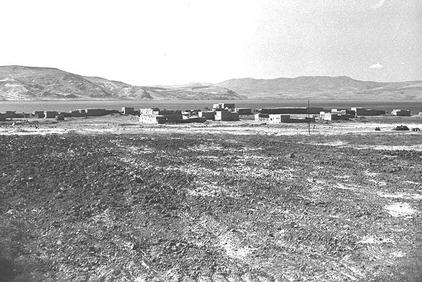Info
District: Tiberias
Population 1948: 340
Occupation date: 01/04/1948
Jewish settlements on village/town land before 1948: None
Jewish settlements on village/town land after 1948: None
Background:
al-Samra before 1948
al-Samra was constructed on flat terrain to the southeastern shore of lake Tiberias, 10km from the city of Tiberias and 3km west of the Syrian-Palestinian border. The village was dominated by the Golan Heights to the east and linked to its closest neighbour village, Samakh, by a secondary road.
The villagers were predominantly Muslim, worshipping in a mosque located in the center of the village. In 1944-45 the village consisted of 290 inhabitants with houses built out of stone and adobe. The main occupation was their agriculture, with 6,825 dunums dedicated to cereals and 21 used for orchards or were irrigated.
The Swiss traveler Burckhardt came to the village in the early nineteenth century, noting its ancient buildings and the fact that it was the only inhabited village on the eastern side of the lake Tiberias. Furthermore, the American biblical scholar, Edward Robinson, was told that the village was on the eastern shore of the lake. The village contained ancient ruins from Roman times, such as a Roman burial ground. 1.5km east of the village was an Ottoman memorial for two Ottoman pilots killed in a crash in 1913.
Occupation and depopulation
On the 21st of April, the village was depopulated as a result of the fall of city of Tiberias. However, some of the villagers must have stayed behind, as some of them were subject to a campaign encouraging their departure from 1949-1956. al-Samra was located in the Demilitarized Zone (DMZ), and was thus protected by the provisions of the armistice agreement. But the Israeli forces used both economic and political pressure in forcing all of the villagers out of al-Samra, with most of these becoming refugees in Syria.
Already in the beginning of May, the Jewish settlers had encouraged the Jewish National Fund (JNF) to establish a settlement of the area.
Israeli settlements on village lands
The Israeli settlement ha-’On was established north of the village site in 1949.
The village today
Today, there are no visible remains of the village houses on the site. A tourist resort with small houses and cabins have been constructed on the site instead whilst other parts of the site are covered in trees. The surrounding land is cultivated by the Israelis.
---------------------------
Source: al-Khalidi, Walid (ed.). All that remains: the Palestinian villages occupied and depopulated by Israel in 1948. Washington DC: 1992.


